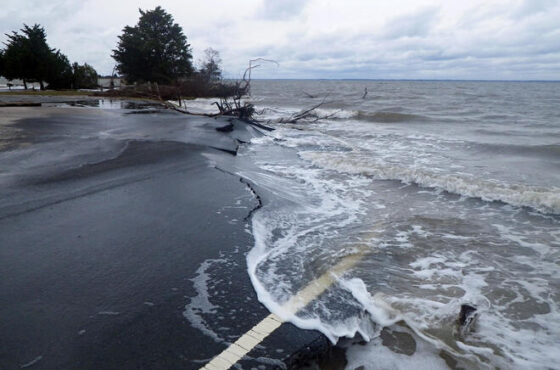Solar on Southern Rooftops? Let’s Call Them “Freedom Panels.”
Published by the Natural Resources Defense Fund

Mike Mahaffie/Flickr
Southerners don’t like regulatory mandates. Take a look at this interactive map. The gaping gray hole noting the lack of renewable portfolio standards is testament to that. Freedom, on the other hand, speaks straight to the southern heart—and that includes the right to put solar panels on your roof if you so wish.
Last year in Georgia, clean power advocates seized upon that sentiment to pass legislation for third-party ownership, allowing homeowners or businesses to avoid the up-front cost of buying solar panels by leasing them from a third party, which then owns the generated electricity from the system. The Peach State is the first state in the Southeast to do so, and the move represents one small step toward taking power out of the hands of the utilities and unlocking a tightly controlled energy grid.
“In Georgia, we’ve marketed to our audience that distributed solar is a property-rights issue, and we won on that,” says Shan Arora, policy programs manager at Southface, a nonprofit that promotes sustainable living. “No matter the property owners’ motivation, whether environmental, economic independence, or national security–related, they should have the right to generate electricity.”
“Distributed generation” is an energy-geek term for electricity produced near its point of use. Think solar panels in the parking lot next to a store, or placed atop a home where the energy makes a short sojourn from panels to house. Setting up your own power source off the main grid is a small act of autonomy, but one that requires policies to make it fiscally worthwhile. The sheer size of utility-scale solar makes it attractive to investors, but distributed generation needs a little push before residents and business owners can start reaping all of its rewards.
“There are a couple of things you need for a good [rooftop] solar market,” says Sean Gallagher, vice president of state affairs for the Solar Energy Industries Association (SEIA). “The first is sunshine, and you don’t even need that much of it. But then you need the set of foundational policies that support solar. These are not widely available in a critical way in the southern states.”
Such policies take numerous forms. They could be sufficient renewable portfolio standards, a state target for how much electricity must be produced by clean energy, or third-party financing and net metering and interconnection laws that protect solar customers from huge financial risk. Combined, these strategies weave a warm welcome mat on a state’s doorstep for installation companies like Solar City and Sunrun to set up shop.
That’s not to say there’s no solar in the South. There is, and it’s growing in concentrated fits and starts, but the bulk is utility scale. North Carolina is third in the country in terms of total installed capacity this year, thanks to its renewable portfolio standard that says 0.2 percent of retail electricity sales must come from solar by 2018. (The state must get 12.5 percent of power from renewables by 2021.) An 35 percent state tax credit helped boost those sales—that is, until the state legislature allowed it to expire last year.
Residential-scale solar, however, is still lagging in the South. The big utilities—Duke Energy, Southern Company, Dominion, South Carolina Gas and Electric—aggressively take the position that they alone can sell the electron.
Utilities have been granted monopoly power, and the public service commissions that regulate them have not had to worry about another entity coming in and challenging that, says Caroline Golin, founder of GreenLink, a clean energy consulting firm based in Atlanta. “They are not actively creating a policy structure to have [distributed generation] in place.”
Take net metering. Without it, a homeowner cannot sell any excess electricity back to the grid for full retail credit. Currently Georgia Power buys power for about 4 cents per kilowatt-hour and then sells it for around 12 cents to someone else—a benefit to the utility, not so much the homeowner. It’s hardly a free market.
Rooftop solar is flourishing in states like California, Hawaii, and New York, partly due to legislation and partly due to high electricity costs. Hawaii has the highest rate at 26 cents per kilowatt-hour. But even with their lower power bills, many southerners still see the benefits of independence, even if partial, from the grid.
A couple of years ago, Pew Charitable Trusts identified Georgia as the “fastest-growing solar market in the country.” Prior to 2009 there was approximately 1 megawatt of solar installed, which rose to 22 megawatts within three years. The state is now on track to exceed 1,000 megawatts of installed solar by the end of this year. The first third-party leasing agreement in the Southeast was signed just last month between Cherry Street Energy and the City of Macon.
Rooftop solar is trying to get a foothold elsewhere in this corner of the country, too. A few years ago South Carolina approved a law enabling solar leasing. One hitch is that nobody except the utility can buy excess electricity under the state’s net metering programs. Again, not quite a free market for the electricity.
Florida is one of four states that currently ban the leasing of solar panels (the others are Kentucky, Oklahoma, and North Carolina). An alliance of solar advocates called Floridians for Solar Choice is trying to get third-party financing on the ballot in their state this November. But for solar to truly have its day in the southern sun, other states would need to welcome net metering and solar leasing as well. Only then would the rooftop solar industry be for the people and by the people where the free market reigns.
“The democratization of electricity is going to take some time,” Arora says, but he remains hopeful. “One thing I’ve learned is the way to win over a southerner is not to point out that we’re behind; nudge us forward instead.”
Related Stories
Read the full article at: https://www.nrdc.org/stories/solar-southern-rooftops-lets-call-them-freedom-panels



